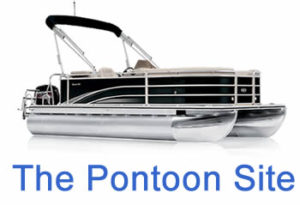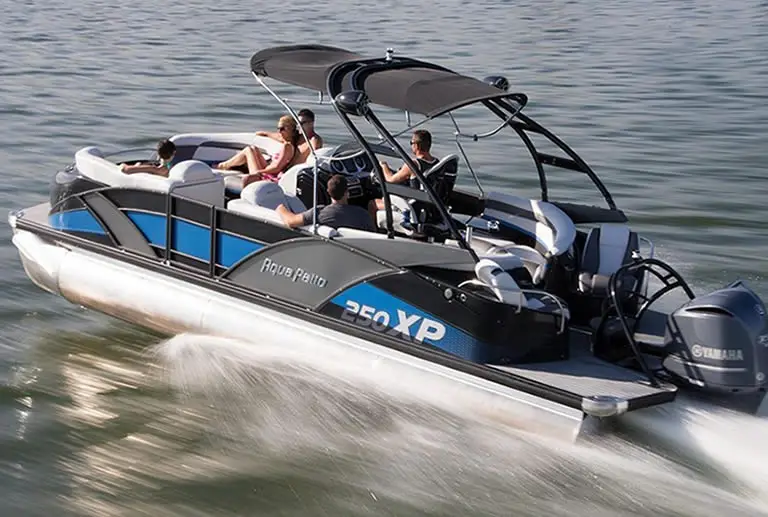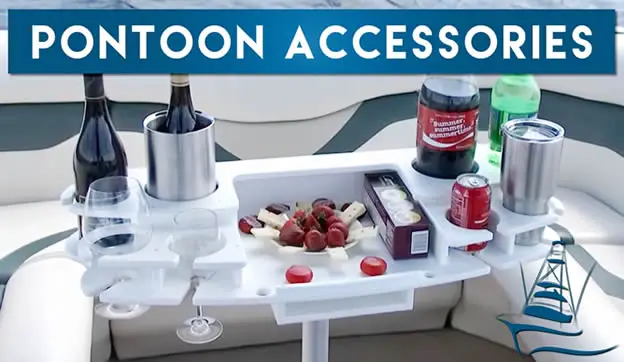If you are new to pontoon boat ownership or are planning a pontoon boat vacation or party then you will want to know how to drive this unique luxury vessel.
In this article I outline the 6 steps you need to take to safely and efficiently drive a pontoon boat.
Contents
- How To Drive A Pontoon Boat In 6 Simple Steps
- 6 Additional Tips For Safely Driving A Pontoon Boat
- Recap: How To Drive A Pontoon Boat
How To Drive A Pontoon Boat In 6 Simple Steps
Driving a pontoon is actually much easier than most people think; learning how to drive a road vehicle is much more challenging.
Pontoon Boats are an excellent choice of flat-bottomed watercraft for those who really appreciate comfort while on the water. The distinctive design structure of this boat is reflected in the name, pontoon, which is derived from the French word ‘pont’, which means “bridge”.
This name was given to this type of boat because such flat-bottomed vessels were historically used as a temporary support for bridges rather than as sailing vessels. So, with its unique design let’s look at how pontoon boats work and what you need to know in order to efficiently and safely drive a pontoon boat.
1. How to engage the engine and prop
Ensure the boat is in neutral before you begin.
On your pontoon boat there should be a battery switch which is set to off. Turn it to the “ON” position.
There may be an emergency stop switch. It should now be set to “RUN”.
There will be a red cord next to the driver’s seat that is attached to an engine “kill switch”. This cord will have a metal trigger clip or carabiner clip to attach to your person. This will easy clip onto a the waistband loops of your pants.
This is an essential safety step that should not be skipped!
The point of this cord, and the reason why it needs to be attached to the driver, is that in the event of the driver losing control of the boat, by either going overboard or being knocked out the driver’s seat, the pontoon boat motors will instantly shut off.
Thus allowing the driver to regain control of the vessel.
Ensure the pontoon boat motor is trimmed down so the prop is in the water.
Now you can turn the ignition switch and start the boat motor.
You are now good to go.
Walkthrough for starting a pontoon boat (video)
2. How to steer a pontoon boat
Steering a pontoon boat is the same as steering a road vehicle.
Use the steering wheel to turn the boat in the direction you want to travel in just the same as as it is with a road vehicle.
Just like a road vehicle you should not attempt any sharp turns while under speed.
Ideally when you are first learning to drive the boat your bow should face the wind, for smoother navigation and easier steering. However, this is not a necessity and with a large boat that has a powerful engine it will be totally unnecessary.
When driving a pontoon boat you will have only one hand on the steering wheel. The other hand is used to operate the throttle.
3. How to regulate your boat speed
The throttle is a lever that regulates your speed and is operated by one hand.
Pushing forward on the throttle makes the pontoon boat go faster.
Eases off the throttle, or pulling it backwards slows the boat down.
A pontoon boat ahs no brakes. You must use the throttle to regulate and check your speed.
4. How to move off
Driving a pontoon boat starts with taking off from the dock.
When you are ready to take off you can shift into a forward gear and move your pontoon boat’s throttle forward. Slow, steady movements will keep the pontoon boat under your control.
Don’t try to accelerate too quickly. Just apply gentle pressure to the throttle until you become accustomed to the responsiveness of the engine.
5. How to drive the pontoon boat whilst underway
- To pick up speed for cruising simply shift into ‘forward’ and gently move your throttle away from you. You will now need your motor to be trimmed downward, so your engine is deeper in the water and the bow is kept steady.
- Your pontoon boat should be driven with one hand on the steering wheel and the other on the throttle.
- When driving keep a lookout at all times for obstructions up to 100 meters ahead. This 100 meter-rule allows you enough time to react and maneuver the boat without having to resort to sharp turns which can tip this type of boat easily.
- Allow similar space and adequate time for performing normal turns.
- Your pontoon boat cruising speed should not be excessively fast. 4500 RPM in open water is adequate, though lower speeds offer much better fuel conservation. Accelerate and decelerate gradually and plan your turns in advance.
6. How to safely dock a pontoon boat
When your dock comes into view, you should start to slow your vessel by gradually shifting your throttle backwards toward you.
Approach the slip at a slow, even speed and keep the center of your bow pointing towards the middle of the slip.
Turn your boat, in forward gear, using very low speed, or no speed at all, so you allow your vessel to essentially glide into position.
If you do not intend to keep your boat in a marina or on the water and instead intend to haul your boat home and you need to know how to load the boat on a trailer read this article on our sister site. You may also want to read our guide to towing a pontoon boat.
The 6 steps to driving a pontoon boat reviewed (video)
6 Additional Tips For Safely Driving A Pontoon Boat
Below are some very important safety tips that can help you drive a pontoon boat more safely and much more efficiently.
Avoid driving a pontoon boat in rough water if you can
If you find yourself in rough water or have taken a pontoon boat out into the open sea, it is important to know how to handle the vessel to keep everyone safe.
Ideally you should always aim to avoid bad weather or rough water when in a pontoon boat. Although a pontoon boat sits on floatation tubes it is essentially a flat-bottomed boat that is designed for optimum stability and comfort in calm water.
Although most pontoon boats are designed primarily to be used as recreational vessels on calm inland waters, they are more than capable of handling rough or challenging waters.
However, be aware that a pontoon boat will not navigate rough waters as smoothly as a deep v-hull boat which is designed for that very purpose. Be aware that rough waters can also wreak havoc with your boat’s playpen if the nosecones dip beneath waves and you take water on board.
Before navigating rough waters pay close attention to your load distribution and keep the vessel balanced.
Larger and heavier vessels are more stable in rough water.
Regardless of the size of your craft, when navigating rough waters, your aim is to keep your vessel’s pontoons above the water.
Here are some tricks to use if you find yourself pontooning in rough waters
Resist the urge to slow down before cruising into large waves, which can put your nosecones beneath the water and cause water to come onboard.
Trim up just before hitting large waves to help lift your boat’s bow.
Drive your pontoon so waves are at an angle of around 45 degrees to your boat’s center to keep your bow high consistently.
If you own your own pontoon boat, as opposed to hiring one, consider adding:
- A package that affords your vessel higher horsepower.
- Power steering.
- Structural additions such as angle lifting strakes or barracuda nosecones to cut into those waves.
Avoid overloading the boat
Ensure you limit passenger numbers and load so the overall weight falls within the capacity limit of your pontoon boat.
Overloading a pontoon boat, or any boat for that matter, will have a huge impact on the boat’s stability. Not only will overloading your boat make the pontoon much harder to drive but it will also make it dangerous to drive.
It is all too easy to overload a pontoon boat especially if you are partying or have a lot of cool pontoon boat accessories onboard.
An overloaded pontoon boat is easy to sink.
Important boat checks to carry out before you drive the boat
Obviously ensure that the boat is in good order. Be especially vigilant when checking the boats steering as faulty steering or a problem with the boat’s rudder will have a huge negative impact on your ability to drive boat.
For additional boat checks make sure that your radio is working and you have adequate fuel for your journey.
Distribute weight evenly across the deck
Securing your cargo and distributing it evenly on your pontoon boat, minimizes hazards while on open water and ensures the boat is neither port or starboard, and/or, bow or stern, heavy.
A bow heavy pontoon boat will nosedive and sink.
Obviously having a boat that is tilting to one side, or that is front or back heavy, will affect your ability to maneuver it properly. This will also create a risk of the boat taking on water and sinking the boat.
Log a boat journey plan if you intend to boat away from the crowds
If you intend to venture far out into the water then it is well worth letting someone onshore know where you are going.
Although most pontoon boats are used for pleasure activities on inland waters or just offshore in open seas, where they are clearly visible from the shoreline, it is still a good idea to let others know that you intend to go out on the water.
Avoid alcohol consumption if driving the pontoon boat
It is important to watch over your passengers and remain sober while navigating your boat so that potential hazards are minimized.
As the skipper you should only consume alcohol if the boat is securely docked and you should never attempt to move it once you begin drinking.
Drinking alcohol will diminish your ability to drive a boat in exactly the same way it would diminish your ability to drive a road vehicle.
Recap: How To Drive A Pontoon Boat
Here is a recap of the above step-by-step guide for starting your pontoon boat and driving off:
- Open the vent in the cap of your boat’s fuel tank and squeeze the rubber priming bulb on the fuel line until it feels firm.
- Raise the idle speed lever halfway, while making sure that the throttle lever is centered.
- Start your engine.
- Allow the boat to idle for a few minutes in-line with manufacturer instructions. Idling warms up the motor.
- Be sure you know how to properly trim your pontoon boat. Doing this properly makes pulling out smoother. Use the trim button on your boat’s throttle (if it has one) to control this process. Take care with trimming your boat, so that the motor just sits in the water.
- Put your throttle in a gentle steady reverse while a member of your crew unties your deck ropes. This will allow you to steadily back out once everyone is seated. You can then back away slowly and carefully paying attention to other water users and nearby obstructions.
- Use the throttle to regulate your speed, being sure to slow down when navigating obstacles or preparing to turn the boat.
- Ease off the throttle when preparing to dock and allow the boat to coast into the dock.



